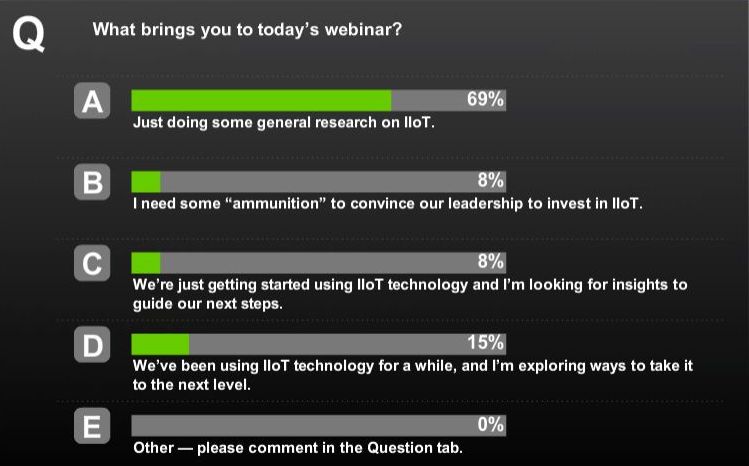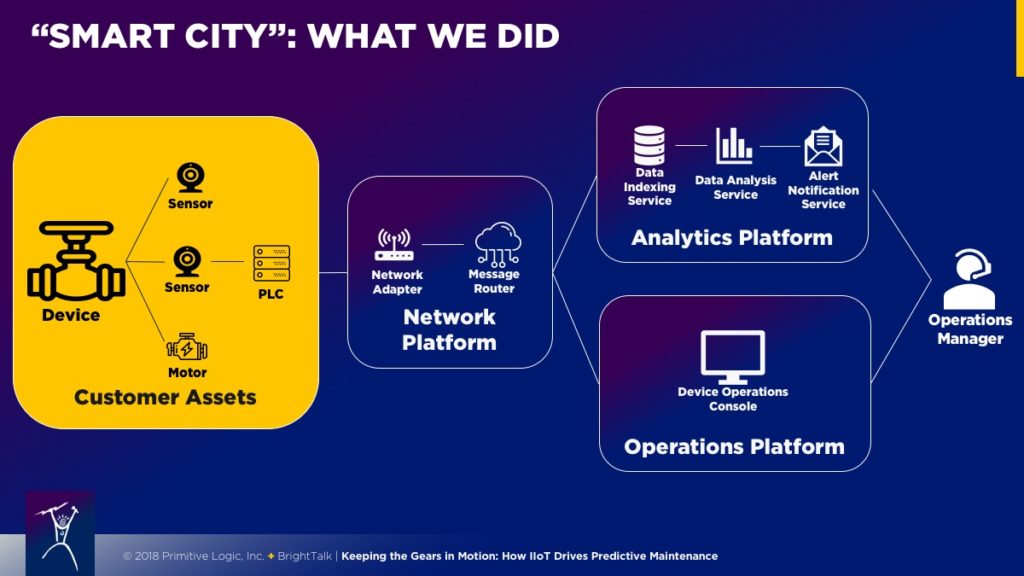Just as the internet of things has made an indelible mark on consumers’ everyday lives, the industrial internet of things (IIoT) is making a similar impact in the world of manufacturing and commercial services, particularly in predictive maintenance. On June 7, we had the pleasure of presenting “Keeping the Gears in Motion: How IIoT Drives Predictive Maintenance” on Primitive Logic’s BrightTALK channel, where we explored how IIoT enables an evolved approach to maintenance and examined a real-world case study from one of our own clients. (If you were unable to join us, you can watch the replay above, or click here if you don’t see the player.)
Poll Results: Momentum Is Building
Early on in the webinar, we invited participants to share with us their reasons for attending, which told us a lot about the state of IIoT adoption. Here’s how they responded:

This technology is gaining traction and will likely become mainstream in a few years, but the early adopters are already ahead of the curve. It didn’t surprise us to see 15 percent of the votes cast for current implementation and adoption. That is impressive for a relatively new technology, and we attribute this accelerated adoption to the positive ROI that IIoT is generating for early adopters.
A Data-Driven Approach to Maintenance
IIoT and the data it produces have enabled industrial maintenance to evolve to a new level. With reactive maintenance, operations teams would replace parts and equipment after they failed, leading to the disruption of unplanned downtime and the additional costs of rush-ordered parts and overtime labor.
If you’ve ever been in the habit of getting the oil changed in your car at regular intervals, you’re familiar with preventive maintenance, which calls for the regular servicing or replacement of equipment according to time (“every three months”) or usage (“every 3,000 miles”). However, time and usage are not always accurate indicators of wear-and-tear, and this approach could lead to replacing a part before needed.
IIoT allows operations managers to take a predictive approach to maintenance using actual performance data. Instead of waiting for a part to fail or making a “best guess” based on time or usage numbers, predictive maintenance uses actual performance data to alert managers when a part is due to fail or needs servicing. Just as many cars’ diagnostic systems send alerts to the driver when a service is needed, an IIoT-enabled network can alert operations managers when a part is about to fail, enabling “just in time” interventions.

Case Study: Building an End-to-End Predictive Maintenance System
One of our clients, a fully automated commercial service provider, wanted to reduce maintenance labor costs and improve reliability. Following a thorough assessment of the client’s challenges on an asset-by-asset level, Primitive Logic leveraged IIoT technology to build a network that uses data to help them stay ahead of maintenance issues.

Our solution featured three integrated platforms that, together with the client’s existing assets, formed an end-to-end predictive maintenance solution.
- The network platform encompasses a network adapter, which we hard-wired to the client’s programmable logic controllers (PLCs), and an intelligent message router that allows the adapter to communicate to the outside world.
- The analytics platform comprises three elements: a data indexing service for classifying the data, a data analytics service to determine baselines and identify outliers, and an alert notification service that sent messages to operations managers when atypical behavior was identified.
- The operations platform enables operations managers to control devices remotely. In the case of a valve, for example, he may decide to close it until a technician can intervene, or he may divert traffic to other valves. Using the device operations console that we built, he can do this from his desktop or even from a mobile device.
Of course, the diagram and description above represent a drastic simplification of what we built for the client, and we delivered a far more detailed explanation for our webinar audience.
As a result of this project, our client was able to reduce technician costs by 80 percent, increase reliability, and improve customer satisfaction.

To learn more about IIoT for predictive maintenance and more insights on how we leveraged it to deliver results for our client, I invite you to view the webinar above, or you can watch it on our BrightTALK channel.